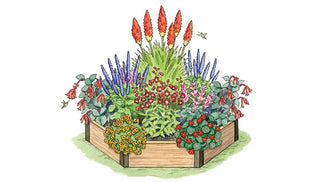Bold flowers in brilliant hues attract these winged wonders. Once hummingbirds discover this garden's buffet of blooms, they'll stick around all summer and return again each spring.
Most of the perennial varieties were chosen for their relatively compact form so they won't overwhelm the bed once they reach their mature size. Feel free to substitute plants. And rather than crowding in additional perennials, try filling in any first-year gaps with additional annual flowers, until the perennials reach their full size.

| Key | # of Plants | Plant Name | Notes |
|---|---|---|---|
| A | 1 plant | Rocket's Red Glare red hot poker (aka torch lily) Kniphofiahybrid |
Grass-like clump is topped with tall, red flowers that resemble bottle brushes. Perennial, zones 6-9. |
| B | 2 plants | Raspberry Daiquiri hummingbird mint Agastache aurantiaca |
Spikes of magenta flowers cover the blue-green, aromatic foliage. Perennial, zones 6-9. |
| C | 2 plants | Rubycunda beardtongue Penstemon barbatus |
Large, tubular blooms are bright red with white throats. Perennial, zones 4-8. |
| D | 2 plants | May Night salvia (aka meadow sage) Salvia hybrid |
Striking spires of purple-blue flowers rise high above the foliage. Perennial, zones 4-9. |
| E | 2 plants | Tassel™ Dark Salmon fuchsia Fuchsia hybrid |
Clusters of salmon-red, tubular flowers adorn the plant all summer. Annual. |
| F | 2 plants | Empress of India nasturtium Tropaeolum majus) |
Crimson flowers hover over the blue-green foliage of this Victorian-era favorite. Annual. |
| G | 2 plants | Terra Cotta Million Bells® Calibrachoa hybrid |
Trumpet-shaped flowers in shades of orange, red, and gold bloom all summer. Annual. |
 With a hexagonal shape inspired by honeycomb cells, our Pollinator Garden Beds can be configured in a variety of ways to suit your space.
With a hexagonal shape inspired by honeycomb cells, our Pollinator Garden Beds can be configured in a variety of ways to suit your space. Add the hexagonal shape lets you add more more Pollinator Garden Beds any time by tucking them close together or placing end to end.
Add the hexagonal shape lets you add more more Pollinator Garden Beds any time by tucking them close together or placing end to end. Brilliant red, tubular honeysuckle flowers are irresistible to hummingbirds.
Brilliant red, tubular honeysuckle flowers are irresistible to hummingbirds. Agastache's common name, hummingbird mint, is a sure sign of its attractiveness to hummers.
Agastache's common name, hummingbird mint, is a sure sign of its attractiveness to hummers.8 Tips for Attracting Pollinators
- Single flowers — those with one ring of petals around a central disc — provide more nectar and pollen than pompom-shaped double flowers.
- Keep gardens blooming and feeders filled! Hummingbirds can consume 100% of their body's weight in sugar water or nectar every day, in addition to as many as 2,000 tiny insects! (Source: Cornell Lab of Ornithology)
- Many pesticides, even organic ones, will harm pollinators. For example, if you use a pesticide to control caterpillars, you risk harming butterfly larvae.
- Bees tend to be most attracted to blue, purple, and yellow flowers, though you'll find them on flowers of other colors, too.
- Include plants that are native to your region. They'll be adapted to your soil and climate conditions and will be magnets for wild bees and other native pollinators.
- Include plants of various heights in your landscape, including flowering trees and shrubs.
- Butterflies, bees, and other pollinators need shelter to hide from predators, get out of the elements, and rear their young. If possible allow a section of your landscape "go wild" with unmown lawn, fallen leaves, and small piles of twigs.
- Pollinators vary in their preference for flower shape (bowl-shaped, flat-topped, tubular, etc.) and color, so include a variety of both in your landscape.




